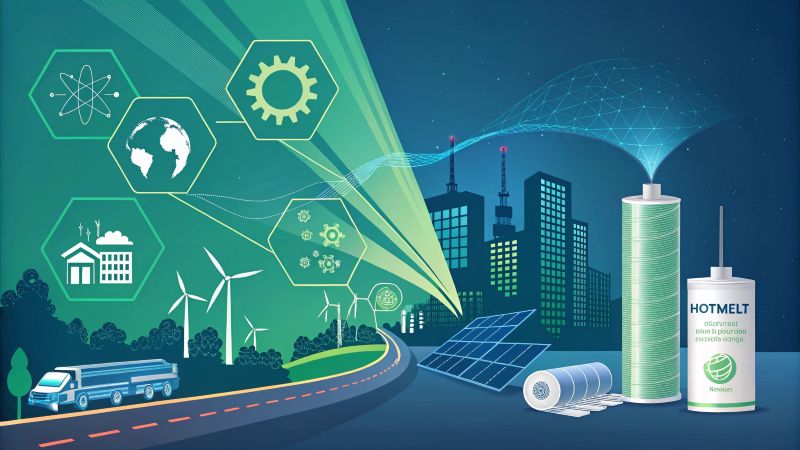
Definition of Hot Melt Adhesives
Types of Hot Melt Adhesives
Importance in Global Markets
Methods of Application
Latest Trends in Adhesives
Strategies for Global Adoption
Future Outlook for Demand
Frequently Asked Questions (FAQ)
Hot melt adhesives (HMAs) are thermoplastic bonding agents that are solid at room temperature and become tacky when heated. They offer rapid setting times, strong bonds, and solvent-free formulation, making them a preferred choice for applications in packaging, automotive components, textiles, and more. Their global appeal continues to rise due to their adaptability, cost-efficiency, and environmentally friendly characteristics.
Several types of hot melt adhesives serve distinct industrial needs:
EVA-based adhesives are widely used in packaging and bookbinding for their affordability and versatility.
Polyolefin adhesives excel in adhering to non-porous and high-temperature surfaces, making them ideal for appliances and automotive interiors.
Polyurethane hot melts provide flexible, durable bonds in textiles and furniture assembly.
Pressure-sensitive hot melts allow for immediate adhesion in labeling and taping applications.
These formulations enable industries to select adhesives tailored to specific technical and environmental demands, fueling international growth.
Hot melt adhesives play a central role in industrial manufacturing worldwide. Their fast bonding capability, reduced curing time, and compatibility with automated systems make them essential in sectors striving for high-volume output. As manufacturers shift toward more sustainable, efficient solutions, solvent-free hot melt adhesives are being adopted globally to meet regulatory and consumer expectations.
Hot melt adhesives are applied using various techniques to match industrial processes:
Manual dispensing tools for low-volume or precise bonding tasks
Roll coaters and slot die systems for uniform application in packaging and lamination
Extrusion and spray systems for high-speed or automated production lines
Choosing the right application method ensures optimal adhesion, reduces waste, and supports process efficiency, making it a strategic factor in global deployment.
Emerging trends are driving innovation in the hot melt adhesive industry:
Sustainability focus: Eco-friendly, solvent-free, and recyclable adhesives are in high demand.
E-commerce packaging: The need for secure, reliable bonding in shipping solutions is growing.
Lightweight materials: Adhesives are increasingly used to replace mechanical fasteners, reducing overall product weight.
Fast curing systems: Optimized for high-speed manufacturing and minimal downtime.
These trends are shaping the next generation of industrial adhesives and expanding their application across global markets.
For broader international adoption, manufacturers are pursuing several strategies:
Product innovation tailored to the needs of specific industries and climate conditions
Global distributor partnerships to improve market access and local support
Sustainable formulation development to align with environmental regulations
Technical education and support to increase end-user familiarity and trust
By aligning offerings with both regional needs and global standards, adhesive producers can strengthen their presence across continents.
The demand for hot melt adhesives is expected to grow steadily, driven by expanding sectors such as logistics, automotive, consumer goods, and electronics. As production methods become faster and more resource-efficient, adhesives that offer strong performance, easy application, and environmental compatibility will be indispensable. Their use will also expand into emerging markets, reinforcing their importance in global manufacturing ecosystems.
What are hot melt adhesives?
They are thermoplastic adhesives that melt when heated and solidify when cooled, enabling rapid and clean bonding for industrial applications.
What types of hot melt adhesives are available?
Common types include EVA-based, polyolefin, polyurethane, and pressure-sensitive hot melts—each suited to different surfaces and performance needs.
Why are hot melt adhesives important in global markets?
They are critical for efficient, scalable, and eco-conscious manufacturing, supporting industries like packaging, textiles, and automotive.
How are hot melt adhesives applied?
Application methods include manual dispensers, roll or slot die coating, and automated extrusion or spray systems.
What are the latest trends in the adhesive industry?
Current trends include eco-friendly formulation, high-speed application, and expanding use in lightweight and e-commerce packaging.
What strategies support global adoption of hot melt adhesives?
Strategies include developing sustainable products, building local distribution networks, and educating users about the benefits and use cases.
What is the future outlook for hot melt adhesive demand?
The outlook is strong, with continued growth in demand expected across global industries focused on speed, safety, and sustainability.
Which products are commonly used in the hot melt adhesive market?
Widely used product types include EVA glues for packaging, polyolefins for high-temperature uses, and PUR adhesives for flexible bonding tasks.